A Brief History of the Gordie Howe International Bridge

With theinstallation of final edge girders on the Gordie Howe International Bridge onJune 14, 2024, the long-awaited connection between the Canadian and UnitedStates sides of the Detroit River transpired.
This momentous occasion was theculmination of a nineteen year journey which began on June 15, 2005, when theMichigan Department of Transportation (MDOT) announced that a new internationalbridge was being proposed by a bi-national partnership between the UnitedStates Federal Highway Commission and Canada’s Ontario Ministry ofTransportation. Its mission was to address “border crossing needs inSoutheastern Michigan and Southwestern Ontario.”
Highwaytraffic research on both sides of the border indicated that the presentAmbassador Bridge, which went into service over ninety years ago in 1929, wasinadequate to meet the region’s future needs. The new bridge project originallyknown as the Detroit River International Crossing (DRIC) would have six lanes withan additional twelve foot wide pedestrian and bike lane, rather than the fourlanes of the current Ambassador Bridge.
Thecable-stayed bridge would have a 138’ clearance from the river and a totallength of 8,202’ (1.5 miles). At its highest point of 722’, the bridge wouldrival the height of Detroit’s Renaissance Center. Two-hundred, sixteen spunsteel cables will support the roadway and bear the traffic weight loads. Thebridge will be illuminated at night with high-powered LED lighting.
The bridgeplazas will have 24 primary inspection lanes and 16 toll booths. The port ofentry and border inspection facilities on the United States side will havededicated exit lanes to connect with Interstate 75, while the Canadian port ofentry’s border inspection facilities and toll collection booths will directlyconnect to Ontario Highway 401.
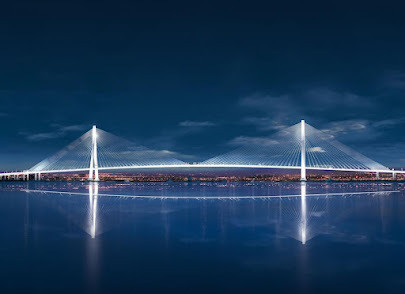 Artist's rendering of Gordie Howe Bridge lit up at night.
Artist's rendering of Gordie Howe Bridge lit up at night.Arguments infavor of the DRIC bridge were:
· It would improve global trade betweenthe two countries.
· It would create an estimated 10,000constructions jobs and 3,350 permanent jobs.
· It would ease the daily traffic jamsand border delays on both sides of the Detroit River.
· It would save fuel, reduce airpollution, and minimize time lost, especially on the Canadian side where semi-truckscould avoid the gauntlet of city traffic lights leading to the AmbassadorBridge.
***
Majoropposition to the DRIC bridge proposal came from the billionaire owner of theAmbassador Bridge, Manuel “Matty” Moroun, who made his fortune in the truckingindustry and from collecting tolls on both ends of the bridge, including owningthe Duty-Free shops.
TheAmbassador Bridge is one of the few international, privately owned toll bridgesin North America. While the Detroit/Windsor Tunnel downtown allowed passengercars and buses through its crossing, the Ambassador Bridge became the only way commercialtruck traffic could cross the Detroit River for almost 100 years, except for slow,obsolete ferry service. Matty Moroun purchased the Ambassador Bridge from theJoseph A. Bower family in 1979 and enjoyed its monopolistic status for over thirtyyears. Now, the DRIC threatened it.
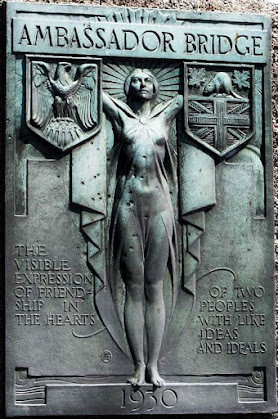 Ambassador Bridge art deco plaque installed midspan.
Ambassador Bridge art deco plaque installed midspan.Moroun usedevery legal delay his lawyers could devise and argued in the courts that hisbridge had “exclusivity rights” granted to him by the previous owners. Thecourts summarily shut down that argument. In desperation, Moroun offered tobuild a six-lane twin span and use the old Ambassador Bridge for foot trafficand special events saying that his proposed project would be less expensive tobuild. The Canadians argued successfully that Mouron’s project would not solvethe underlying traffic problems in the Windsor metropolitan area.
Moroun switchedfrom the court battles to the political arena after losing a lawsuit brought bythe MDOT in 2009 for his failure to construct new ramps to connect theAmbassador Bridge directly to Interstate 75 in violation of a previously negotiatedcontact. Michigan Republicans began voicing their support for Mouron and oppositionto the DRIC bridge project.
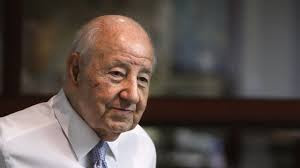 Manuel "Matty" Moroun
Manuel "Matty" MorounIn 2010, Moroun’sopposition to the new bridge prompted the Canadian government to offer to payMichigan’s portion for the new span in exchange for collecting all tolls fromthe bridge for the next fifty years to reimburse Canada. Michigan Senator AlanCropsey, Republican from DeWitt County, remained opposed to the Canadian offer.“The new bridge is unnecessary, and it would put an American businessman(Moroun) out of business. Is this some kind of foreign aid?”
Dan Stampler,president of Moroun’s Detroit International Bridge Company, warned that jobscreated for the DRIC would go to Canadians casting doubt on Michigan’s GovernorJennifer Granholm’s loyalty as a Canadian born United States citizen forsupporting the Canadian funding proposal. “She has offered to sell the Michiganborder to Canada,” Stampler said.
GovernorGranholm quickly refuted the broadside charge as “Totally absurd! When it comesto jobs and expansion on both sides of the border, this is the only game intown.” The political battle raged on.
In 2011, theMichigan Senate rejected a bill that would have allowed the state to accept a$550 million cash advance to fund the United States portion of the bridgeconstruction. United States special interest politics interfered with thebill’s passage. The new Michigan Republican Governor Rick Snyder threw hissupport behind the DRIC bridge bill in his State of the State address tellinghis party that economic growth was his top priority. “It is time to solveproblems,” he said.
In a last-ditcheffort to enforce his will, Moroun promoted a proposal for an amendment to theMichigan Constitution requiring approval for the new bridge construction by notonly Detroit voters, but also Michigan voters at large in statewide elections.The ballot proposal was defeated by a wide 60% to 40% margin. Mouron’saggressive lobbying and litigating had worn thin with Michigan voters pavingthe way for the project to proceed.
***
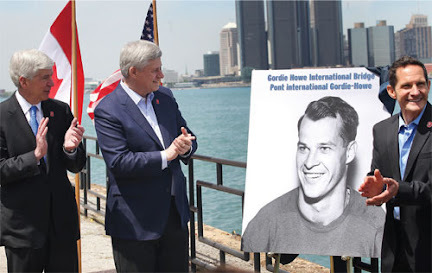
On May 14,2015 in a ceremony along the Detroit River on the Canadian side, MichiganGovernor Rick Snyder, Canadian Prime Minister Stephen Harper, and Gordie Howe’sson Murray Howe jointly announced that the publicly owned DRIC bridge would berenamed the Gordie Howe International Bridge, after a native Canadian whoplayed hockey for the Detroit Red Wings leading them to four Stanley Cupvictories. Because of his prowess on the ice, Howe earned the nickname “Mr.Hockey.” In his remarks at the naming ceremony, Prime Minister Harper said, “GordieHowe was a proud Canadian who built extraordinary goodwill between the twocountries.”
On October26, 2014, Howe had a stroke while at his daughter’s home. At the time of the naming ceremony announcement, Gordie Howe suffered from dementia and could not attend. His son told him about the honor bestowed upon him. Howe said, “Thatsounds pretty good to me.” Thirteen months later on June 19, 2016, he died athis son’s home in Sylvania, Ohio of undisclosed causes at the age of eighty-eight,two years before groundbreaking on the bridge began.
Howe’scasket was brought to the Joe Louis Arena for public visitation. The followingday, his funeral was held at Detroit’s Cathedral of the Most Blessed Sacrament.Acting as pallbearers were hockey great Wayne Gretsky, winningest NHL coachScotty Bowman, and Detroit Tiger legend Al Kaline. Howe’s remains were returned toCanada and interred in Saskatoon, Saskatchewan.
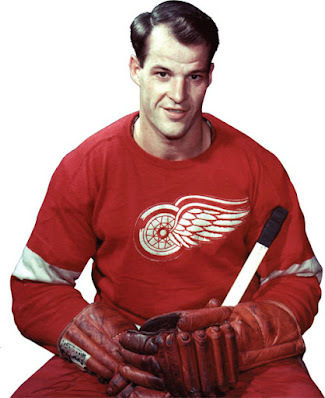 Mr. Hockey--Gordie Howe
Mr. Hockey--Gordie Howe***
Constructionofficially began on the Gordie Howe International Bridge in 2018, but the completionand opening have been delayed due to the COVID-19 pandemic in 2020. The long-awaitedbridge opening is now scheduled for the fall of 2025 once the bridge plazas,signage, and traffic lights are installed. People on both sides of the DetroitRiver look forward with anticipation to the ribbon cutting ceremony marking theend of a twenty year odyssey.



